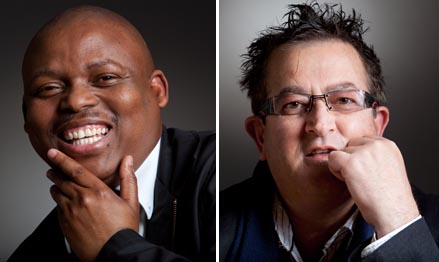|

|
|
Prof Martin Ntwaeaborwa (left) and Prof Bennie Viljoen
20 May 2013 |
Two professors received research grants from the National Research Foundation (NRF). The money will be used for the purchase of equipment to add more value to their research and take the university further in specific research fields.
Prof Martin Ntwaeaborwa from the Department of Physics has received a R10 million award, following a successful application to the National Nanotechnology Equipment Programme (NNEP) of the NRF for a high-resolution field emission scanning electron microscope (SEM) with integrated cathodoluminescence (CL) and energy dispersive X-ray spectrometers (EDS).
Prof Bennie Viljoen from the Department of Microbial, Biochemical and Food Biotechnology has also been awarded R1,171 million, following a successful application to the Research Infrastructure Support Programme (RISP) for the purchase of a LECO CHN628 Series Elemental Analyser with a Sulphur add-on module.
Prof Ntwaeaborwa says the SEM-CL-EDS’ state-of-the art equipment combines three different techniques in one and it is capable of analysing a variety of materials ranging from bulk to individual nanoparticles. This combination is the first of its kind in Africa. This equipment is specifically designed for nanotechnology and can analyse particles as small as 5nm in diameter, a scale which the old tungsten SEM at the Centre of Microscopy cannot achieve.
The equipment will be used to simultaneously analyse the shapes and sizes of submicron particles, chemical composition and cathodoluminescence properties of materials. The SEM-CL-EDS is a multi-user facility and it will be used for multi- and interdisciplinary research involving physics, chemistry, materials science, life sciences and geological sciences. It will be housed at the Centre of Microscopy.
“I have no doubt that this equipment is going to give our university a great leap forward in research in the fields of electron microscopy and cathodoluminescence,” Prof Ntwaeaborwa said.
Prof Viljoen says the analyser is used to determine nitrogen, carbon/nitrogen, and carbon/hydrogen/nitrogen in organic matrices. The instrument utilises a combustion technique and provides a result within 4,5 minutes for all the elements being determined. In addition to the above, the machine also offers a sulphur add-on module which provides sulphur analysis for any element combination. The CHN 628 S module is specifically designed to determine the sulphur content in a wide variety of organic materials such as coal and fuel oils, as well as some inorganic materials such as soil, cement and limestone.
The necessity of environmental protection has stimulated the development of various methods, allowing the determination of different pollutants in the natural environment, including methods for determining inorganic nitrogen ions, carbon and sulphur. Many of the methods used so far have proven insufficiently sensitive, selective or inaccurate. The availability of the LECO analyser in a research programme on environmental pollution/ food security will facilitate accurate and rapid quantification of these elements. Ions in water, waste water, air, food products and other complex matrix samples have become a major problem and studies are showing that these pollutants are likely to cause severe declines in native plant communities and eventually food security.
“With the addition of the analyser, we will be able to identify these polluted areas, including air, water and land pollution, in an attempt to enhance food security,” Viljoen said. “Excess levels of nitrogen and phosphorous wreaking havoc on human health and food security, will be investigated.”